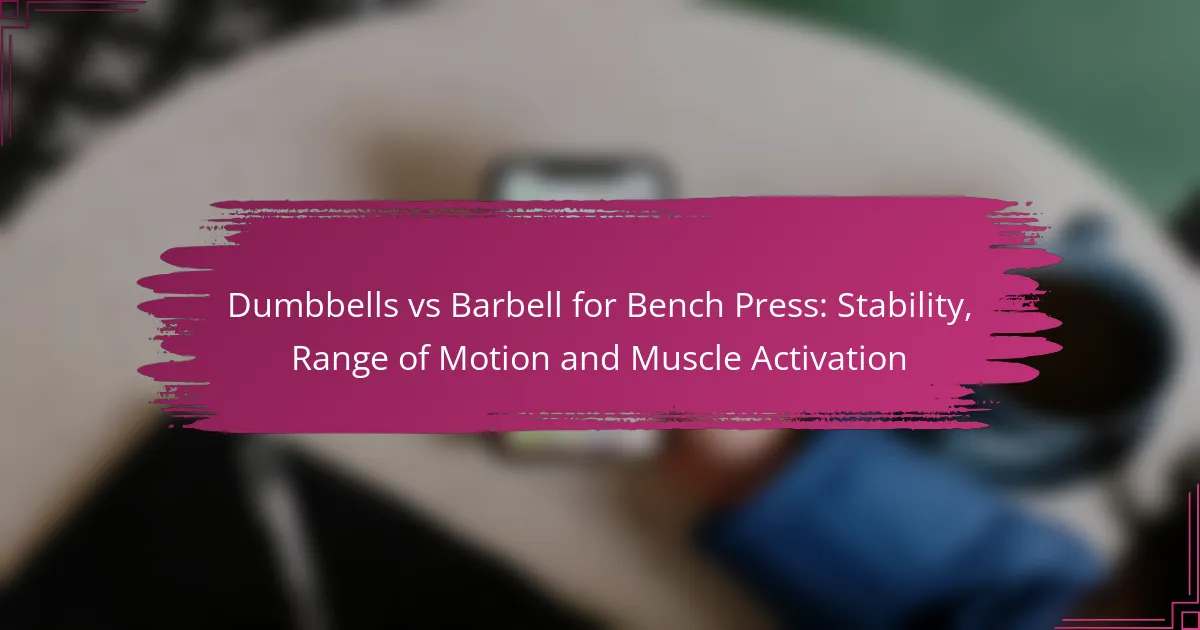The flat, incline, and decline bench presses are essential variations that target different areas of the chest and contribute to overall strength development. Selecting the right type depends on your specific fitness goals and the muscle groups you aim to enhance. By understanding the unique benefits of each variation, you can effectively tailor your workout routine to meet your needs.

Which bench press variation is best for building strength?
The best bench press variation for building strength depends on your specific goals. The flat, incline, and decline bench presses each target different areas of the chest and can be used strategically to enhance overall strength and muscle development.
Flat bench press for overall strength
The flat bench press is a fundamental exercise for overall upper body strength, primarily targeting the pectoral muscles, triceps, and shoulders. It allows for the use of heavier weights, which is crucial for building strength effectively.
When performing the flat bench press, ensure your feet are firmly planted on the ground, and maintain a controlled movement throughout the lift. Aim for 3-5 sets of 6-10 repetitions for optimal strength gains.
Incline bench press for upper chest development
The incline bench press focuses on the upper portion of the pectoral muscles, making it essential for balanced chest development. By adjusting the bench to a 30-45 degree angle, you shift the emphasis away from the lower chest and engage the shoulders more.
Incorporate the incline bench press into your routine if you want to improve the aesthetics of your upper chest. Similar to the flat bench, aim for 3-4 sets of 8-12 repetitions to promote hypertrophy while still building strength.
Decline bench press for lower chest focus
The decline bench press targets the lower chest more effectively than the flat or incline variations. By positioning the bench at a downward angle, you can emphasize the lower pectoral muscles, which can help create a fuller chest appearance.
This variation is less commonly used but can be beneficial for those looking to enhance their lower chest. Perform 3-4 sets of 8-12 repetitions, ensuring proper form to maximize effectiveness and minimize injury risk.

When should you use flat, incline, or decline bench press?
Choosing between flat, incline, and decline bench press depends on your fitness goals and the muscle groups you want to target. Each variation offers unique benefits and can be incorporated into your routine based on your specific needs.
Flat bench press for general workouts
The flat bench press is a staple for overall upper body strength, primarily targeting the chest, shoulders, and triceps. It is ideal for beginners and those looking to build a solid foundation in their strength training regimen.
When performing the flat bench press, ensure your feet are planted firmly on the ground, and your back is flat against the bench. Aim for a rep range of 6-12 for muscle growth, adjusting the weight to maintain proper form throughout your sets.
Incline bench press for targeting specific muscle groups
The incline bench press shifts the focus to the upper chest and shoulders, making it a great choice for those looking to enhance their upper body aesthetics. This variation can help create a more balanced chest development.
To execute the incline bench press, set the bench to a 30-45 degree angle. Use a weight that allows you to perform 8-12 reps with good form. Incorporate this exercise into your routine if you want to improve your pressing strength in the upper chest area.
Decline bench press for advanced lifters
The decline bench press is less commonly used but can be beneficial for targeting the lower chest. It is typically recommended for more experienced lifters looking to diversify their training and focus on specific muscle areas.
For the decline bench press, adjust the bench to a downward angle and ensure you are securely positioned. This variation can be performed with a rep range of 6-10 for strength gains. Be cautious with the weight, as this position may feel less stable than the flat or incline variations.

What are the benefits of each bench press type?
Each type of bench press offers unique benefits that target different muscle groups and enhance overall strength. Understanding these advantages can help you choose the right variation for your fitness goals.
Benefits of flat bench press
The flat bench press primarily targets the pectoral muscles, along with the triceps and shoulders. It is a fundamental exercise for building overall upper body strength and mass.
This variation allows for heavier weights to be lifted, making it ideal for those looking to increase their maximum strength. It also serves as a great foundation for other pressing movements.
Benefits of incline bench press
The incline bench press shifts the focus to the upper part of the chest, shoulders, and triceps. This variation helps develop the upper chest, which can improve the overall aesthetics of your physique.
Using an incline angle, typically between 30 to 45 degrees, can also reduce shoulder strain compared to flat pressing. This makes it a suitable option for those recovering from shoulder injuries while still wanting to engage their chest muscles.
Benefits of decline bench press
The decline bench press emphasizes the lower portion of the pectoral muscles, providing a different angle of resistance. This can lead to a more balanced chest development when combined with flat and incline presses.
This variation often allows for a greater range of motion and can be easier on the shoulders for some lifters. It’s a good option for those looking to diversify their training and target specific areas of the chest more effectively.

How do you choose the right bench press for your goals?
Choosing the right bench press depends on your specific fitness goals, current fitness level, and the equipment available to you. Each variation—flat, incline, or decline—targets different muscle groups and can be more effective depending on what you want to achieve.
Assessing your fitness level
Your fitness level plays a crucial role in selecting the appropriate bench press. Beginners may benefit from starting with the flat bench press to build foundational strength, while more advanced lifters can incorporate incline and decline variations to target specific muscles. Always consider your ability to maintain proper form and avoid injury.
If you’re unsure about your fitness level, consider consulting a trainer or performing a self-assessment to gauge your strength and experience with bench pressing. This will help you choose the right variation that aligns with your capabilities.
Identifying your muscle development goals
Your muscle development goals will significantly influence your choice of bench press. The flat bench press primarily targets the chest, shoulders, and triceps, making it ideal for overall upper body strength. The incline bench press emphasizes the upper chest and shoulders, while the decline bench press focuses more on the lower chest.
If your goal is to enhance upper chest development, the incline bench press is the better option. Conversely, if you want to emphasize the lower chest, the decline bench press should be included in your routine. Tailor your choice based on which muscle groups you aim to develop.
Considering equipment availability
Equipment availability can dictate which bench press variations you can realistically incorporate into your workout routine. Many gyms offer all three types of benches, but if you’re training at home, you may need to prioritize based on what you have access to.
If you only have a flat bench, focus on mastering that before considering other variations. Alternatively, if you have adjustable benches, you can easily switch between incline and decline settings to diversify your training. Always ensure that the equipment is safe and stable before use.

What are common mistakes to avoid in bench pressing?
Common mistakes in bench pressing can lead to injuries and hinder progress. Focusing on proper form, adequate warm-ups, and appropriate weight selection is crucial for safe and effective workouts.
Improper form leading to injury
Using improper form during bench pressing is a primary cause of injury. Key aspects include keeping your feet flat on the ground, maintaining a neutral spine, and ensuring your wrists are aligned with your elbows. A common error is flaring the elbows out too wide, which can strain the shoulders.
To avoid injury, consider having a trainer or experienced lifter observe your form. Regularly filming your lifts can also help you identify and correct any form issues.
Neglecting warm-up routines
Skipping warm-up routines can increase the risk of injury and reduce performance. A proper warm-up should include dynamic stretches and lighter sets of bench presses to prepare the muscles and joints. Aim for at least 5-10 minutes of warm-up before heavy lifting.
Incorporating mobility exercises for the shoulders and chest can enhance your range of motion and overall effectiveness during the bench press. Simple movements like arm circles and band pull-aparts can be beneficial.
Using too much weight
Using too much weight is a frequent mistake that can compromise form and lead to injuries. It’s essential to select a weight that allows you to complete your sets with proper technique. Generally, starting with a weight that is about 60-70% of your one-rep max is a good guideline for most lifters.
Progressively increasing the weight as you build strength is important, but avoid the temptation to lift more than you can handle. If you struggle to maintain form or require assistance, it’s a sign to reduce the weight.



